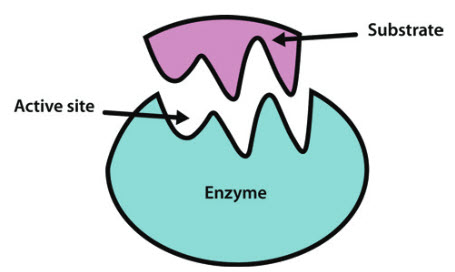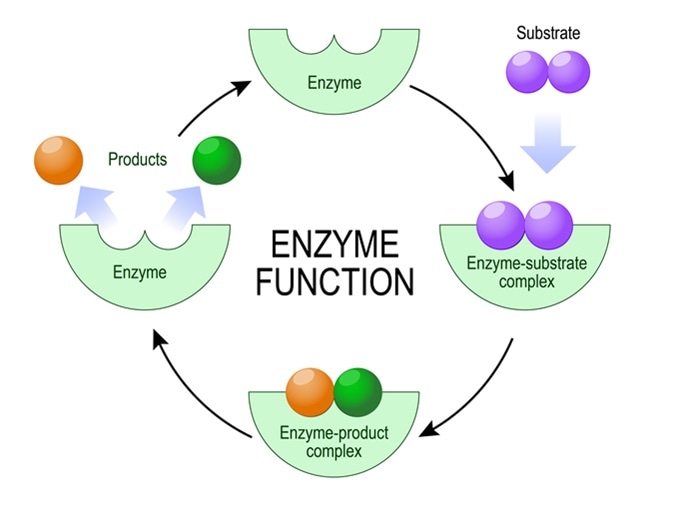Describe the Structure of an Enzyme
Many enzymes are made up exclusively of protein and such enzymes are called simple enzymes. National Science Foundation Summary.

Chapter 6 Enzyme Principles And Biotechnological Applications Chemistry
Co-factors co-enzymes and vitamins.

. It is the location where substrate molecules are produced. Enzymes are actually made up of 1000s of amino acids that are linked in a specific way to form different enzymes. Terms in this set 26 enzymes made of protein polypeptide chains of amino acids have specific shape work with one type of substrate can work on catabolic braking or anabolic building reactions.
Start studying Enzyme Structure and Function. 31 Enzyme Structure Overview. Enzymes 10 marks 250 words Describe the structure of enzymes and how this is important in determining its function.
Enzyme structure and function. Ø Some enzymes require no chemical groups for activity other than their amino acid residues. The nonprotein part of the conjugated enzyme is called cofactor.
Coenzyme A has a complex structure consisting of an adenosine triphosphate a pantothenic acid which is a B-vitamin and cysteamine. An enzyme is a type of protein found within a cell. Such enzymes are known as conjugated enzymes or holoenzymes.
It always has a geometrical shape exactly complementary to that of substrate. It always accommodates several structurally related substrates. Functions of Enzymes.
The enzyme chains fold over to form unique shapes and it is these shapes that provide the enzyme with its characteristic chemical potential. December 4 1998 Source. Enzymes and activation energy.
But in the process the structure or composition of the enzymes remain unaltered. They break down large molecules into smaller substances that can be easily absorbed by the body. For an enzyme-mediated chemical reaction to occur the shape and charge of the substrate must be compatible with the active site of the enzyme.
Scientists Describe Structure Of An Enzyme That Uses Iron To Make Hydrogen Date. In many enzymes there is found a non-protein part associated with protein. This is the primary structure of enzymes.
While they hasten or speed up a process they are actually providing an alternative pathway for the process. In many enzymes there is found a non-protein part associated with protein. Learn vocabulary terms and more with flashcards games and other study tools.
Substrate enters active site induced fit weakens substrate bond. Such enzymes are known as conjugated enzymes or holoenzymes. Construct a timeline to describe the major event in the history of coral reefs in Ka-neohe Bay in Hawaii.
Describe the properties of enzymes. What does it mean to be a conjugated protein. Indicate whether each of the following statements about an enzyme active site is true or false.
All enzymes are proteins composed of amino acid chains linked together by peptide bonds. It always has a fixed rigid geometry. Ø Enzymes are much larger than their substrates.
All enzymes have a highly specific binding site or active site to which their substrate binds to produce an enzyme-substrate complex. The protein part of the conjugated enzyme is called apoenzyme. The sulfhydryl -SH group of cysteamine moiety of this coenzyme forms a thioester with the carboxyl -COOH group of the acyl-compound such as acetic acid to produce acetyl-CoA which is one.
2-16 comprises 2 nucleotides one consisting of adenine ribose and phosphate and the other nicotinamide ribose and phosphate linked by a pyrophosphate bond. The structure of enzymes includes the active site that specifically interacts with substrate molecules. Six types of enzymes.
What is the role of insulin. The enzyme chains fold over to form unique shapes and it is. Enzymes are actually made up of thousands of amino acids that are linked in a specific way to form different enzymes.
The protein part of the conjugated enzyme is called apoenzyme. Introduction to enzymes and catalysis. Their folded chains of amino acids can be represented by simple shapes.
Describe the structure of haemoglobin. Enzymes help in signal transduction. Describe the structural properties of a globular protein.
Using an example of an enzyme involved in metabolism pathways further explain factors that can regulate the rate of enzyme-catalysed reactions. An enzyme molecule may have one or more of these polypeptide chains. Most enzymes also contain a non-protein component known as the co-factor.
The coenzyme is involved in transfer of acyl-groups. Select all of the following that can be used to describe the structure of enzymes the importance of the shape and the relationship of enzyme shape and function. What organ secretes insulin.
The sequence of amino acids within the polypeptide chains is distinct in each enzyme and this is what determines the unique three-dimensional shape in which the chains are folded. The most common enzyme used in the process includes protein kinase that catalyzes the phosphorylation of proteins. The workings of an iron-laden bacterial enzyme could.
Enzyme Structure Function. Amino acids are linked by hydrogen bonds with various chemical groups attached to give enzymes their two dimensional shape Amino acids are linked by hydrogen bonds with various chemical. Enzyme has empty active site 2.
Enzymes are proteins that consist of chains of amino acids connected together by peptide bonds. All enzymes are made up of proteins but all proteins are not enzymes. The co-factors are of three types.
What is the role of haemoglobin. Ø Others enzymes require additional chemical components one or more for their activity. This is the currently selected item.
Structure of Enzymes. They help in generating. Induced fit model of enzyme catalysis.
Describe the structure of insulin. Describe the structure of amylase. What is a globular protein.
Its structure see fig. Ø Most of the enzymes consist of multi-subunits more than one polypeptide chains. Enzymes create chemical reactions in the body and can actually speed up the rate of.

What Is Enzyme In Biology Structure Location And Function Biology Enzymes Life Science

No comments for "Describe the Structure of an Enzyme"
Post a Comment